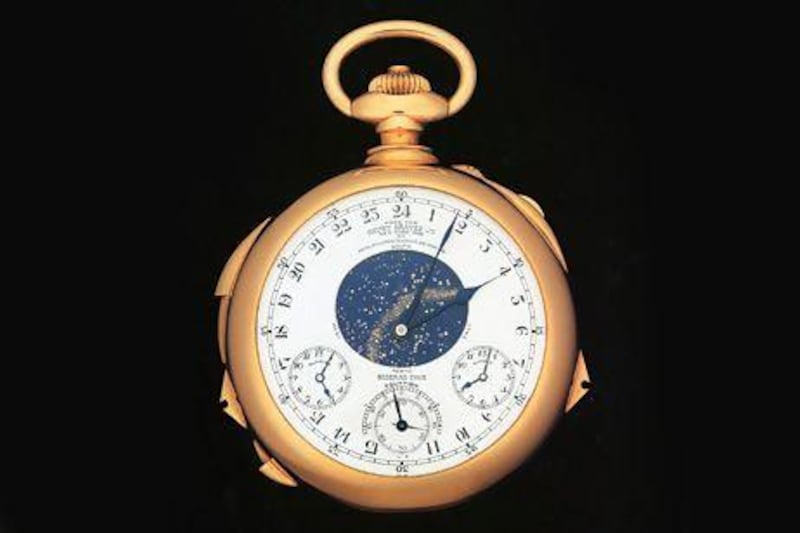Alfredo Paramico, an investment banker, owns arguably one of the most collectable vintage watches in the world.
The stainless steel Patek Philippe, reference 1518, was one of just a handful made during the Second World War when there was an embargo on precious metal exports from Switzerland.
The Italian financier paid €2.2 million (Dh10.4m) for it in 2007 - five times what the owner at the time bought it for in the 1990s. But he estimates it could be worth up to €5m today.
It is, by any standards, a good return. While not all vintage watches can match it, Mr Paramico insists there is plenty of money to be made in antique timepieces.
And he can illustrate his belief: he has spent about 90 per cent of his career earnings on his obsession and owns 10 vintage timepieces in all worth an estimated €20m - but is not just a collector.
He also manages what is believed to be the world's only open-ended investment watch fund: Precious Time, which was launched amid much interest early last year.
"We had this press conference about two months before," says Mr Paramico.
"We had more than 200 people attending this event. We had to take another room because there were so many people."
As of last month, the fund had notched a 22.5 per cent gain since inception. It managed assets of €22.8m as of the end of October and currently owns 640 watches.
But perhaps profitability is not so surprising in relation to the size of the vintage watch market for Patek Philippe, Rolex, Audemars Piguet and Cartier, which is worth an estimated €5 billion annually, according to Precious Time.
Yet just because a watch is old does not mean it is as valuable as Mr Paramico's timepiece. And some brands are a better investment than others.
"Patek Philippe watches are the [top choice] of any watch collector," says Joe Haj Ali, a Dubai collector.
"Patek Philippe are made in smaller numbers compared to the other high-end watches and the high degree of materials, artistry and finishing and final quality that goes into each watch is remarkable. Add to that the strength and timeliness of the iconic brand, even for pieces that are 100 years old."
This goes some way to explain why Pateks hold the most records for the top prices paid at auction. In 1999, a pocket watch made for the financier Henry Graves Jr sold for US$11m (Dh40.4m).
And just last month, a platinum Patek Philippe chronograph, reference 2458, which was made in 1952 for the collector JB Champion, fetched a shade under 3.8m Swiss francs (Dh14.9m), setting a world record for a watch without complications. In horology - the study of clocks and watches - complication refers to any feature in a timepiece beyond the simple display of hours, minutes, and seconds.
The buyer of the platinum Patek? Mr Paramico's fund, Precious Time.
Mr Ali, 47, who is Lebanese by birth and works as the general manager and chief marketing officer for a telecoms holding company, will not say how many watches he owns, except that it is a "large collection".
He is a customer of Momentum, the UAE's only vintage watch shop, based in Dubai International Financial Centre.
"I was the only student who was allowed to enter the teachers' room," says Tariq Malik, the Momentum co-founder and a collector who started selling watches as a schoolboy in Germany.
"They called me Mr Malik from when I was 15 or 16."
He got into collecting watches after spotting an opportunity in the Swatch watch craze, which swept Europe in the early 1990s.
"I saw the incredible increase in price. [A watch] was still available in the store but it was double the price in the collectors' market because in the store they wouldn't sell you two. They would register your name and only sell you one Swatch watch," he says.
The market for collecting Swatch watches eventually collapsed, at which point Mr Malik got into high-end vintage watches. His first purchase was a 1961 Rolex Oyster that he bought for about Dh1,800 in the early 1990s. It is worth about nine times that today.
He says business has been brisk at Momentum since the shop opened in November last year. It began with a stock of 60 watches, which has grown to about 190 today.
"It's the brands you know: Patek Philippe; Rolex; Omega; these are the world's best brands," he says.
The shop sources all of its watches in Europe through a team based in Germany who meet private vintage dealers, individuals and regular dealers. They also attend auctions and trade shows. Prices at Momentum start at about Dh800 and go into the tens of thousands, depending on the brand, reference number and condition.
"Our focus was to approach everyone, even those people who go and buy their first Omega Seamaster vintage for Dh3,000 and start their passion," Mr Malik says.
The shop sells 20 to 25 pieces a month, about 30 per cent of which are bought by people new to collecting, and the same proportion again by those looking to invest, he estimates.
But which brand to buy?
After Patek Philippe, Audemars Piguet, Jaeger-LeCoultre and Rolex are the best investments, according to Mr Malik.
"A lot of people don't understand that Rolex belongs to the four best brands in the world, because Patek Philippe is entirely handmade watch, Audemars Piguet is a brand which has existed for 450 years, Jaeger-LeCoultre also has a lot of history behind it. Rolex, on the other hand, is a mass producer, manufacturing about 700,000 watches a year.
"That's quite a lot but because the value of the Rolex, if you look at it from a percentage increase, is almost comparable to the other brands, I count it among the four best brands in the world," says Mr Malik.
However, if you want to start collecting watches you had better have a passion for it, otherwise it becomes work and is counter-productive, says Oliver Wulff, a collector based in Dubai of military watches, some of which were recently on display at Momentum.
"Also, if you collect watches also with a view towards investing you shouldn't have too much passion for it because you then end up buying watches at the wrong prices."
Mr Paramico only buys Pateks for himself but invests a maximum of 50 per cent of value in the brand. The reason is simple.
"If you want to collect very important Patek Philippe you have to spend $3m, $4m or $5m in order to get the best of the best of the best," he says.
"In my collection [I have them]. In the fund, no, but for one reason: I cannot buy for a fund, which as of today manages €23m or €24m. I cannot buy a €4m watch because I will have too much [money] concentrated [in one asset]."
It took Mr Paramico four years to get his hands on his most precious timepiece: the 1518 stainless steel Patek.
He knew the owner and tried to buy the watch many times. But he refused all advances until Mr Paramico bumped into him at an auction in 2007, when the collector wanted to buy a contemporary watch. Mr Paramico spotted his opportunity and made him an offer, which was accepted instantly.
The watch is "probably the most important" ever, according to Mr Paramico. He told Bloomberg this year that when he shook the seller's hand he felt like he could have "walked on a lake".
But he is surprisingly unmoved about wearing his watches.
"[I wear them] but not in Milano because I don't see the point. I like to collect them. I like to know that I have them," he says.
"But I don't really love to wear watches in general."






